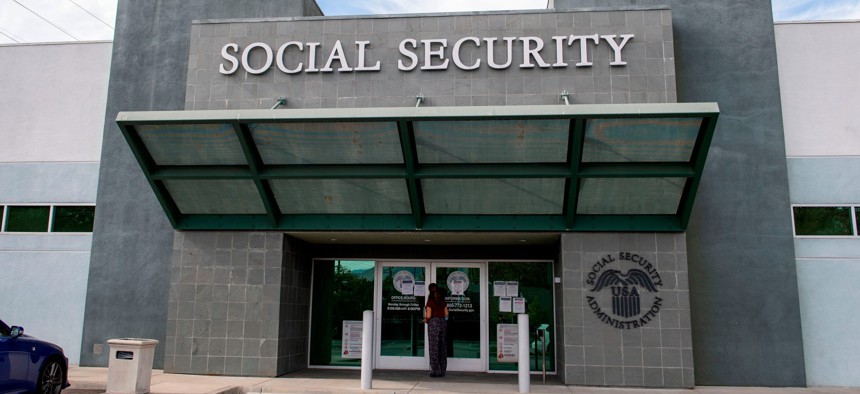
A woman stands outside a US Social Security Administration building, November 5, 2020, in Burbank, Calif. Valerie Macon/AFP via Getty Images
SSA Beta Launches Redesigned Website
The Social Security Administration is collecting feedback on a website redesign before using it to replace the agency's current website later this year. A major goal: making it all less confusing.
The Social Security Administration is out with a new, beta version of sections of its website, part of an ongoing effort to redesign the agency's online presence both for current retirees who may find it confusing and for future retirees who are digital natives.
"I like to say that someday I will be using the services that we're creating here," Kim Baldwin Sparks, chief business officer at SSA, told FCW. "We all have a sense of wanting to leave for our generations and beyond something that is perhaps easier to navigate as an individual, especially online."
This redesign is an effort that started a little over a year ago, she says, before the Biden administration released an executive order specifically directing agencies to improve customer experience, but the effort still falls in line with the government-wide push to make services easier to use.
The new beta version of the website, announced in an April 18 blog post, was built with the help of the U.S. Digital Service. The agency is asking for feedback via a button on the beta page itself. Agency officials say they'll use that feedback to improve the site before replacing the current SSA.gov website later this year.
New content in beta version is limited to a few sections, including the homepage and some retirement material, said Eric Powers, executive advisor at SSA who's been working on the project. Other sections of the site will be rolled out in coming months.
"Our customers told us that we need to do a better job at making it easy for people to find the things that they need to do," said Powers. "They come to us to do things, so we're trying to make the website a much more transactional place to get service, rather than to inform the customer."
Sparks pointed to a user-centered design process that specifically incorporated user feedback and an effort to make the language on the website easier to understand.
The new site features an interactive benefits eligibility screener, for example, that offers a guided question-and-answer process to help people on the website understand what SSA benefits they might be eligible for and point them to how to apply.
"In general our customers, the public, do not understand all of the programs that Social Security might have for them, or are very overwhelmed regarding eligibility and other criteria necessary to receive those benefits," Powers said.
SSA is working with US Digital Service on other efforts for cross-government program support that could link citizens to benefits across different agencies that they're eligible for, Powers said, and outcomes in those efforts will inform the SSA website in the future.
Beyond this "first stage" of guiding a citizen to the services they're looking for is "going deeper and looking at the full customer journey as to how our applications and processes support the customer," Powers said.
The CX executive order, for example, tasked SSA with creating a mobile-accessible, online process for Americans to be able to upload the documentation or forms for SSA programs online without going into a physical office. The agency said in budget documents that it planned to report to the Office of Management and Budget by April 12 on opportunities for process reforms that could support more virtual and digital services. SSA also plans to support digital signatures and online document uploads.
Another aspect of digital government services that's gotten the spotlight recently is online security and access, especially the identity verification tools used by agencies. In particular, the IRS has faced criticism for its use of ID.me, an identity verification company that offers facial recognition services.
Currently, both Login.gov and ID.me are offered on the SSA sign-in page for online accounts. The "create an account" link directs users to Login.gov.
This redesign didn't touch on authentication, said Sparks.
But security features did surface in the feedback gathered for the website, said Powers.
"Access to our services and information is important to people. When they run into barriers with technology or processes, it always comes up," he explained.
"But at the same time, we hear that people do understand that their information is very critical and needs to be protected," Powers said. "There is a concerted effort to improve on the rates that we can support the customer without running into any issue."







